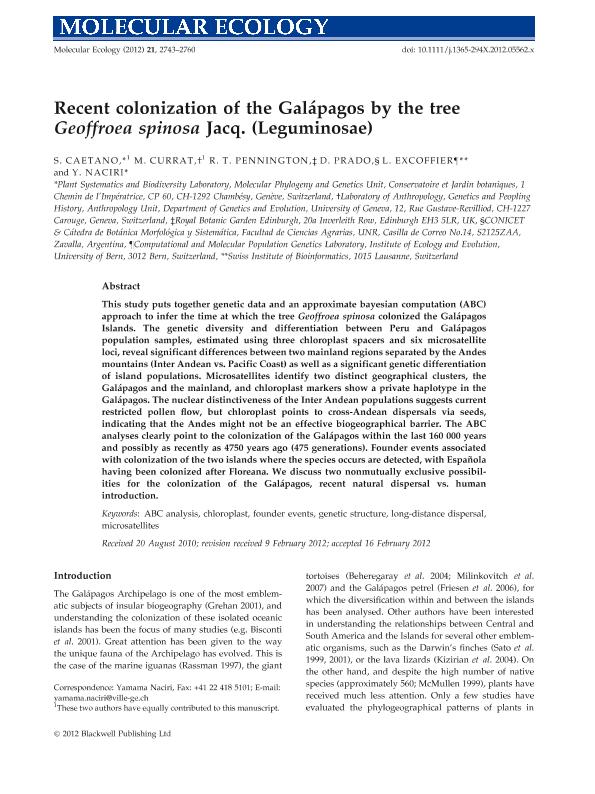Artículo
Recent colonization of the Galápagos by the tree Geoffroea spinosa Jacq. (Leguminosae)
Fecha de publicación:
04/2012
Editorial:
Wiley Blackwell Publishing, Inc
Revista:
Molecular Ecology
ISSN:
0962-1083
Idioma:
Inglés
Tipo de recurso:
Artículo publicado
Clasificación temática:
Resumen
This study puts together genetic data and an approximate bayesian computation (ABC) approach to infer the time at which the tree Geoffroea spinosa colonized the Galápagos Islands. The genetic diversity and differentiation between Peru and Galápagos population samples, estimated using three chloroplast spacers and six microsatellite loci, reveal significant differences between two mainland regions separated by the Andes mountains (Inter Andean vs. Pacific Coast) as well as a significant genetic differentiation of island populations. Microsatellites identify two distinct geographical clusters, the Galápagos and the mainland, and chloroplast markers show a private haplotype in the Galápagos. The nuclear distinctiveness of the Inter Andean populations suggests current restricted pollen flow, but chloroplast points to cross-Andean dispersals via seeds, indicating that the Andes might not be an effective biogeographical barrier. The ABC analyses clearly point to the colonization of the Galápagos within the last 160 000 years and possibly as recently as 4750 years ago (475 generations). Founder events associated with colonization of the two islands where the species occurs are detected, with Española having been colonized after Floreana. We discuss two nonmutually exclusive possibilities for the colonization of the Galápagos, recent natural dispersal vs. human introduction.
Archivos asociados
Licencia
Identificadores
Colecciones
Articulos(CCT - ROSARIO)
Articulos de CTRO.CIENTIFICO TECNOL.CONICET - ROSARIO
Articulos de CTRO.CIENTIFICO TECNOL.CONICET - ROSARIO
Citación
Caetano S.; Currat M.; Pennington, R. T.; Prado, Darien Eros; Excoffier L.; et al.; Recent colonization of the Galápagos by the tree Geoffroea spinosa Jacq. (Leguminosae); Wiley Blackwell Publishing, Inc; Molecular Ecology; 21; 11; 4-2012; 2743-2760
Compartir
Altmétricas




